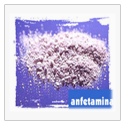|
|||||||||||||||||||
|
Types of Drugs
Amphetamines
There are several products on the market that can be classified into one of those three categories. They are: Benzidine and Bifetamina, pure amphetamine, Dexedrine, a sulfate destroanfetamina with molecular structure similar to the hormone epinephrine (adrenaline), which is a substance secreted in the human body by the adrenal gland in times of fear; Dexamil, a combination of dextroamphetamine and amobarbital, a sedative; Methedrine and Desoxyn, methamphetamine pure; Desbutal and Obedrin, combinations of methamphetamine and pentobarbital, a barbiturate, and Amphaplex, a cocktail of methamphetamine, amphetamine and dextroamphetamine. Preludin, a drug that differs chemically amphetamines, is framed in this group to cause the same effects. In pure form, amphetamines are in the form of yellowish crystals with bitter taste Intrago. Usually taken orally in capsules or tablets of five milligrams, amphetamines can also be consumed intravenously (diluted in distilled water) or aspirated in powder form. Amphetamine appeared in the 19th century and was first synthesized in Germany in 1887. Some 40 years later, the drug began to be used by doctors to relieve fatigue, extending the nasal and bronchial passages and stimulate the central nervous system. In 1932, was launched in France the first commercial version of the drug, under the name Benzedrine in the form of powder for inhalation. Five years later, the Benzedrine came in the form of pills, selling over 50 million units in the first three years after its introduction in the market. During World War II both the Allies and the Axis powers systematically employed amphetamines to boost morale, increase endurance and eliminate fatigue from their combat forces. German troops, as the Panzers, employed the Methedrine. Already Benzedrine was used by the staff of the U.S. Air Force stationed at American bases in Britain. In the territory of the United States, however, the use of amphetamines by military personnel was only officially authorized from the Korean War. The feverish production of amphetamines to meet the pilots of the Luftwaffe, the air force of Hitler, created surpluses that caused an epidemic amphetamine in Japan near the end of the war, the factory workers of Japanese ammunition received generous supplies of drugs, which was announced as a solution to eliminate the drowsiness and pack the spirit. As a result, in the immediate postwar period, Japan had 500 thousand addicts. A little later, in the early 50's, the U.S. military serving in Japan and South Korea became the first to use the speedball, an injection mixture of amphetamine and heroin. Another amphetamine epidemic happened in Sweden in 1965, after the drug began to be provided by the National Health Service. Thousands of people took advantage of the fact that amphetamine is distributed free to consume quantities of substance abuse, until it was made illegal some time later. In recent decades, amphetamine has been used in mass treatments to lose weight, since the drug is effective in temporarily suppressing the appetite. However, as time passes, the body develops tolerance to amphetamine and it is necessary to significantly increasing doses to achieve the same effect. Loss of appetite generated by its constant use can turn into anorexia, a condition in which the person is experiencing difficulty eating and swallowing even soft foods, resulting in severe weight loss, malnutrition and even death. For a long time, amphetamine was also used to treat depression, epilepsy, Parkinson's and narcolepsy. Currently, only the remains using the narcolepsy drug treatment. Amphetamines act by stimulating the central nervous system through an intensification of norepinephrine, a neuro-hormone which activates parts of the sympathetic nervous system. Similar effects to those produced by adrenaline in the brain are caused by amphetamines, leading to the heart and body systems to function at high speed. Result: the heartbeat is accelerated and blood pressure rises enough. By acting on the control centers of the hypo thalamus, while reducing the gastrointestinal activity, the drug suppresses the appetite and its effect can last from four to 14 hours depending on dosage. Amphetamine is rapidly assimilated into the bloodstream and, soon after being ingested, causes chills followed by feelings of confidence and conceit. Pupils dilate, respiration becomes breathless, the heart beats frantically and speech is hit. Then, the User of the drug can enter a state of euphoria and high, while his body is shaken with an intense release of energy. When this energy is extinguished, the effect begins to decline, being replaced by restlessness, nervousness and agitation, through fatigue, paranoia and depression. If there are sensations of drug abuse often leads to headaches, palpitations, dispersivity and confusion. Since the effect is short-lived and ends in depression, the User is required to take subsequent doses, which increase the amount of amphetamine consumed as the body is getting used to the drug. The cycle of abuse and dependence can create a toxic reaction in the body, known as amphetamine psychosis, which can last for several weeks, with irritability, insomnia, hallucinations and even death in extreme cases. The dreams of those who abuse amphetamines are disturbed and interrupted, and your sleep is just sleep. Amphetamines are drugs commonly associated with cases of doping in horse racing, football matches and other sports competitions. |
||||||||||||||||||

 Under the general heading of amphetamines, there are three categories of synthetic drugs that differ from the chemical point of view. Amphetamines, themselves, are destroanfetamina and methamphetamine.
Under the general heading of amphetamines, there are three categories of synthetic drugs that differ from the chemical point of view. Amphetamines, themselves, are destroanfetamina and methamphetamine.